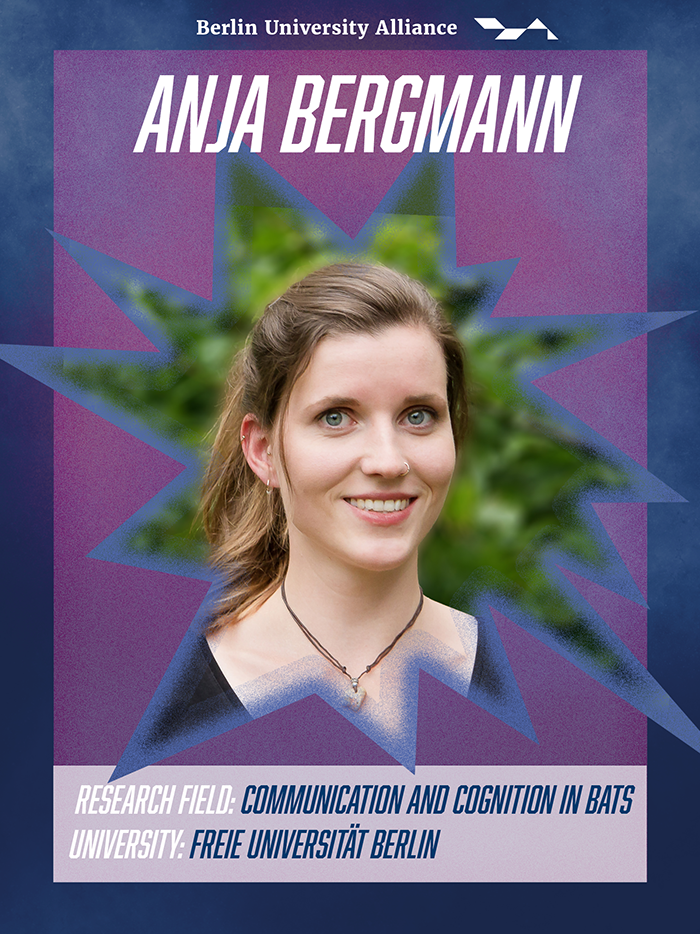Anja Interview
Anja Bergmann:
Freie Universität Berlin,
Communication and Cognition in Bats
1. What is your field of research?
I am a biologist, with focus on behavioral ecology, bioacoustics, and animal communication. My doctoral research centered on the autumn swarming behavior of bats at one of Northern Germany's largest hibernacula (winter roosts). I conducted extensive observations to distinguish between swarming bat species based on their echolocation calls and to track seasonal changes in their swarming patterns. Additionally, I studied the social vocalizations of swarming bats, as the swarming behavior has a highly communicative function. With playback experiments, I aimed to decipher the meaning of different social calls.
2. Why are you participating in "Berlin is looking for the Sciencefluencer 2024"?
I am participating in 'Berlin is looking for the Sciencefluencer 2024' because I believe that as scientists, effective communication is essential. While we excel in our research, outreach beyond the academic community often requires additional skills that we may not be formally trained in. This program offers an opportunity for me to gain valuable insights and expertise in science communication to engage with a broader audience. I am eager to enhance my communication skills and contribute to bridging the gap between science and society.
3. What challenges do you face when you become a science influencer?
One of the key challenges for me as a science influencer is identifying and communicating topics that resonate with a broader audience while ensuring scientific accuracy and relevance. This involves finding engaging subjects that bridge the gap between scientific research and everyday life, fostering interest and understanding among diverse communities. Additionally, amidst the flood of information on platforms like LinkedIn, it can be overwhelming to decide what content to contribute and how it will be received. However, I've already learned that valuable contributions can be made even without feeling like an expert in every subject.
Furthermore, balancing the demands of science communication with ongoing research commitments requires effective time management and prioritization.
4. What are your most important findings in your particular field of research?
One of the most significant findings in my field of research is the development of a method to distinguish between bat species during swarming based on the 'soundscape' they produce while echolocating. This advancement goes beyond the traditional analysis of single calls commonly used for species identification. Additionally, by studying the function of different social calls, we hope to gain further insights into bat behavior and habitat use.
Understanding seasonal changes in habitat use and behavior of endangered species is crucial for their conservation. By applying this knowledge, we can implement more effective conservation strategies to protect these species and their habitats.
5. What are your goals for the future?
I am eager to continue my research journey and have recently begun working on a new project that explores the evolutionary origins of echolocation. Specifically, I am investigating whether echolocation, as a sophisticated orientation tool, evolved from social calls in ancestral species. This project represents a shift towards more fundamental research and involves fieldwork in the Neotropics. I am excited about the opportunity to gain new insights and look forward to the discoveries and challenges ahead!
6. Do you have a funny anecdote from the life of a researcher you can share?
During my research, I encountered unexpected hurdles, as is often the case in fieldwork. As bats are nocturnal, I had to do my observations in front of a cave at night. Despite my best efforts to avoid horror films prior to my field time, I sometimes found myself hesitant to review footage from the night shot camera immediately. Have you seen Paranormal Activity? Most of the paranormal activity happens in said recordings. To avoid potential scares in the field, I waited until I was safely back at my housing to review the material.
One night, I hastily left my observation site due to unusual noises, resembling laughter emanating from the bushes. In hindsight, I'm fairly certain it was just a brown owl. What did I learn about myself? Well, it's a bit embarrassing to admit, but I discovered that I'm a bit of a scaredy-cat!

